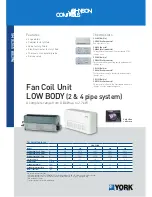
at a later time or if you want to manually adjust the gain settings
(not recommended) (
Adjusting the Autopilot Gain Settings
).
Gain
: Sets how tightly the autopilot holds the heading and how
aggressively it makes turns.
Counter Gain
: Sets how aggressively the autopilot adjusts any
over-steering after making a turn.
Setting North
Before you can begin this procedure, you must have a large
stretch of open water available.
This procedure appears if the autopilot is connected to an
optional GPS device, and the device has acquired a GPS
position. During this procedure, the autopilot aligns the compass
heading with the Course over Ground (COG) information from
the GPS device.
If you do not have a GPS device connected, you are prompted
to set the fine heading adjustment instead (
).
1
Drive your boat at in a straight line at cruising speed,
downwind, and in the same direction as the current.
2
Select an option:
• If you are performing this procedure as part of the
Sea
Trial Wizard
, select
Begin
.
• If you are performing this procedure outside of the
Sea
Trial Wizard
on a helm control, from the heading screen,
select
Menu
>
Setup
>
Dealer Autopilot Setup
>
Compass Setup
>
Set North
>
Begin
.
• If you are performing this procedure outside of the
Sea
Trial Wizard
on a chartplotter, select
Settings
>
My
Vessel
>
Autopilot Installation Setup
>
Compass
Setup
>
Set North
>
Begin
.
3
Continue to drive the boat in a straight line at cruising speed,
downwind, in the same direction as the current, and follow
the on-screen instructions.
4
Select an option:
• If the calibration completes successfully, select
Done
.
• If the calibration is not successful, repeat steps 1 through
3.
Setting the Fine Heading Adjustment
This procedure appears only if you do not have an optional GPS
device connected to the autopilot. If the autopilot is connected to
a GPS device that has acquired a GPS position, you are
prompted to set north instead (
).
1
Select an option:
• If you are performing this procedure as part of the
Sea
Trial Wizard
, proceed to step 3.
• If you are performing this calibration outside of the
Sea
Trial Wizard
on a helm control, from the heading screen,
select
Menu
>
Setup
>
Dealer Autopilot Setup
>
Compass Setup
>
Fine Heading Adjustment
.
• If you are performing this calibration outside of the
Sea
Trial Wizard
on a chartplotter, select
Settings
>
My
Vessel
>
Autopilot Installation Setup
>
Compass
Setup
>
Fine Heading Adjustment
>
Begin
.
2
Adjust the fine heading setting until it shows the correct
heading as determined by a trusted heading indicator, such
as the ship compass or a handheld compass.
3
Select
Back
.
Testing and Adjusting the Configuration
NOTICE
Test the autopilot at a slow speed. After the autopilot has been
tested and adjusted at a slow speed, test it at a higher speed to
simulate normal operating conditions.
1
Drive the boat in one direction with the autopilot engaged
(heading hold).
The boat may oscillate slightly, but it should not oscillate
significantly.
2
Turn the boat in one direction using the autopilot and observe
the behavior.
The boat should turn smoothly, not too quickly or too slowly.
When you turn the boat using the autopilot, the boat should
approach and settle on the desired heading with minimal
overshoot and oscillation.
3
Select an option:
• If the boat turns too quickly or too sluggishly, adjust the
autopilot acceleration limiter (
).
• If the heading hold oscillates significantly or the boat does
not correct when turning, adjust the autopilot gain
(
Adjusting the Autopilot Gain Settings
).
• If the boat turns smoothly, the heading hold oscillates only
slightly or not at all, the boat adjusts the heading correctly,
the configuration is correct. No further adjustments are
necessary.
Adjusting the Acceleration Limiter Settings
1
On a helm control, enable Dealer Mode (
Configuration on the Helm Control
).
2
Select an option:
• On a helm control, from the heading screen, select
Menu
>
Setup
>
Dealer Autopilot Setup
>
Autopilot Tuning
>
Acceleration Limiter
.
• On a chartplotter, select
Settings
>
My Vessel
>
Autopilot Installation Setup
>
Autopilot Tuning
>
Accel. Limiter
.
3
Select an option:
• Increase the setting if the autopilot turns too quickly.
• Decrease the setting if the autopilot turns too slowly.
When you manually adjust the acceleration limiter, make
relatively small adjustments. Test the change before making
additional adjustments.
4
Test the autopilot configuration.
5
Repeat steps 2 through 4 until the autopilot performance is
satisfactory.
Adjusting the Autopilot Gain Settings
The autopilot gain settings are set during the Autotune
procedure. Adjusting these values is not recommended, and you
should record the values set by the Autotune procedure before
making any changes.
1
On a helm control, enable Dealer Mode (
Configuration on the Helm Control
).
2
Select an option:
• On a helm control, from the heading screen, select
Menu
>
Setup
>
Dealer Autopilot Setup
>
Autopilot Tuning
>
Rudder Gains
.
• On a chartplotter, select
Settings
>
My Vessel
>
Autopilot Installation Setup
>
Autopilot Tuning
>
Rudder Gains
.
3
Select an option based on the type of boat:
• If you have a planing-hull powerboat with the speed
source set to
Tachometer - NMEA 2000
,
Tachometer
, or
3
Содержание Reactor 40 Kicker
Страница 6: ...support garmin com ...
























